Health Benefits of Wheat Germ, Uses And Its Side Effects
Last Updated: Sep 03, 2020
The health benefits of wheat germ are such that it helps in boosting the immune system, improves the cardiovascular health, helps in cancer prevention, has anti-aging properties, increases athletic performance.
Wheat germ also improves cellular metabolism, helps in boosting muscle health, supports pregnancy, helps in preventing diabetes, promotes regularity, helps with weight gain, provides a natural solution to healthy and glowing skin.
Wheat Germ
Wheat germ is the small, nutrient-containing centre of a wheat kernel, comprising only about 2.5% of the weight of the kernel, but packing a very beneficial list of attributes.
wheat germ is a concentrated source of several essential nutrients, including Vitamin E, folate (folic acid), phosphorus, thiamine, zinc, and magnesium, as well as essential fatty acids and fatty alcohols. It is a good source of fibre.
White bread is made by using the flour that has had the germ and bran removed. Wheat germ can be added to protein shakes, casseroles, muffins, pancakes, cereals, yogurt, smoothies, cookies, and other goods.Nutritional Value of Wheat Germ
Let's check out nutritional benefits of wheat germ, One ounce (or 28 grams) of wheat germ contains approximately 101 calories, 14.5 grams of carbohydrate, 6.5 grams of protein, 2.7 grams of fat, 3.7 grams of fibre, 3.7 milligrams of manganese, 0.5 milligram of thiamine, 22.2 micrograms of selenium, 236 milligrams of phosphorus, 3.4 milligrams of zinc, 78.7 micrograms of folate. Wheat germ also contain 0.4 milligram of vitamin B6, 66.9 milligrams of magnesium, 0.2 milligrams of copper, 1.9 milligrams of niacin, 1.8 milligrams of iron, 0.1 milligram of riboflavin, 250 milligrams of potassium and 0.6 milligram of pantothenic acid.
Nutritional facts Per 100 Grams
Health Benefits of Wheat Germ
After checking out nutritional details of wheat germ check out the best health benefits of consuming Wheat Germ. We also check out is there any side of wheat germ or not. Also, the cultivation process of wheat germ.
Wheat germ helps in boosting the immune system
By adding wheat germ to one’s diet, he or she can positively boost their immune system to fight against a number of diseases and conditions like heart disease and cancer. Wheat germ protein, hydrolysates, has been shown to positively increase the antioxidant activity in organic systems.
Antioxidants in wheat germ seek out and destroy free radicals and other disease-causing microorganisms in the body, reducing or eliminating the chances of serious illness. It has been shown to naturally contain high levels of these hydrolysates that stimulate the antioxidants within the immune system.
Wheat germ helps in improving the cardiovascular health
Studies have shown that the regular intake of whole grain wheat and wheat germ can reduce risk factors associated with coronary heart disease and can increase the health of the entire cardiovascular system. LDL cholesterol is the cholesterol that has been oxidized and therefore, swells in the arteries and veins.
This is a common sign and risk factor for heart attacks and strokes. Including wheat germ in a person’s diet increases the amount of dietary fibre, which has also been scientifically linked to a reduction in heart disease.
Wheat germ helps in cancer prevention
Adding wheat germ or certain types of wheat germ extracts to a person’s diet can help to reduce the risk factors for multiple types of cancer. It has been shown to interrupt glucose metabolism at a fundamental level and inhibits the expression of various kinases, which stimulate cancerous activity in the cells.
Wheat germ has anti-aging properties
Wheat germ is packed with nutrients and vitamins in such high levels that it can have significant effects on various anti-aging effects like skin quality and hair loss. As a dietary supplement, wheat germ is a natural way to get these benefits, but some people also choose to go for a more cosmetic approach, using its extract directly or mixing it with other cosmetic materials.
Vitamin E is packed into Wheat germ as well, and studies have shown a wide range of benefits to people who fill their daily requirements of this vitamin. When eaten regularly, the proteins and vitamins within wheat germ can positively affect people with conditions like psoriasis, sunburn, eczema, wrinkles, dull complexion, and receding hairlines.
Wheat germ helps in increasing athletic performance
Recent researches have shown wheat germ to have high levels of naturally occurring octacosanol, which has certain ergogenic qualities. This means that when taken as a part of a regular diet, it can increase stamina and performance by regulating the biochemical pathways that produce energy, which in effect streamlines the saving of energy reserves in the body.
Wheat germ helps in improving cellular metabolism
Another beneficial vitamin found in wheat germ is Vitamin B, which consists of a number of other vitamins. The most common types found in wheat germ are Niacin, Thiamine, and folates. These vitamins are vital for cellular metabolism, helping to transform nutrients from carbohydrates, lipids, and glucose into consumable energy for the cells.
Thiamine can also fight against metabolic disorders like chronic obesity. A higher functioning metabolism means more natural energy, as well as more successful weight loss, strength, and alertness. B vitamins can be found in many whole grains as well as in wheat germ.
Wheat germ helps in boosting muscle health
One of the best sources of protein in a diet can come from wheat germ. Protein is integral in maintaining healthy muscles, repairing damaged tissues, regulating energy levels within the body, and aiding in homeostasis and overall system balance. Protein is also an essential dietary requirement for people wanting to get in shape and increase their muscle mass.
Wheat germ during pregnancy
Wheat germ is loaded with folic acid, which is an important factor in ensuring a healthy infant for pregnant women. Women who have healthy levels of folates in their system have a greatly reduced chance of their child having neural tube defects and other complications.
Adding wheat germ in the diet of pregnant women can be beneficial in many ways, given for its nutrient-packed nature, but the high levels of folic acid make it particularly attractive and popular.
Wheat germ good for diabetics
The presence of high level of folic acid in wheat germ has a secondary effect for people at risk of diabetes. Folic acid is negatively correlated with a compound called “homocysteine” in the body, which is closely linked to a number of harmful conditions, like vascular disease, diabetes, and heart disease.
Folic acid is present in many whole grains, and in particularly high levels in wheat germ. Therefore, if one adds normal, healthy doses of wheat germ to their diet, it can help to reduce the levels of homocysteine in the body, and reduce the chances of contracting these dangerous or lethal conditions.
Wheat germ helps in promoting regularity
Adding a dash of wheat germ into a person’s oatmeal, yogurt or smoothie is an excellent way to bump up the intake of dietary fibre and stay regular with minimal effort required on their part. Just one ounce contains a whopping four grams of fibre.
When fibre is eaten, it moves through the body undigested and adds bulk to stool to help ease its passage and prevent straining and constipation.
Wheat germ helps in gain weight
If a person is looking to gain weight, throwing in a few servings of wheat germ may help do the trick. Each ounce contains 101 calories, so a few servings per day could help increase the calorie intake and lead to weight gain over time.
Wheat germ provides natural solution to healthy and glowing skin
As a rich source of antioxidants, wheat germ provides solution to the healthy cell regenerations. In other words, the body will never lack of stock of healthy new cells, especially the skin cells. That is why consumption of wheat germ gives a healthy and glowing skin. Furthermore, a person can not only consume the wheat germ but can also apply it as masker to get rid of dead cells in the skin surface.
Uses of Wheat Germ
Wheat kernels were used mainly to mill flour, in which case the bran and germ parts were casually thrown away and white flour was produced, which held little or no nutritional value, but now wheat germ is also used to make flour.
When it is extracted from the wheat germ and isolated into natural oils, or when the grain is eaten entirely, the nutritional benefits of the germ can be passed into our body. It is often turned into cooking or baking oil for highly concentrated doses of wheat germ on salads or in pasta sauces, but it should not be used as a frying oil because most of the nutrients are lost when heated to that level.
It can also act as an additive in desserts or smoothies, or even as a replacement for breadcrumbs or flour in many recipes, conferring a wealth of nutritional benefits on those that choose to add it to their diet.
Side-Effects & Allergies of Wheat Germ
Consumption of wheat germ is likely safe. However, there are a few side effects associated with wheat germ as well. A growing number of the population can no longer eat gluten, which is a primary component in grains like wheat germ.
This gluten intolerance can often be caused by disease, like Celiac’s disease. Eating gluten can be painful and harmful to the digestive tract, and even fatal in some extreme conditions. So, persons who are sensitive to gluten must avoid the consumption of wheat germ.
Besides being nutrient-rich, wheat germ is very high in calories. The positive benefits of wheat germ can be canceled out if the intake of other daily calories is not monitored because weight gain and subsequent health issues can occur regardless of how healthy the food is, that contributed to your high caloric intake.
Some other side effects of having wheat germ include symptoms like nausea, diarrhoea, indigestion or itchiness.
Cultivation of Wheat Germ
Wheat germ is believed to have originated in southwestern Asia. Some of the earliest remains of the crop have been found in Syria, Jordan, and Turkey. Primitive relatives of present day wheat have been discovered in some of the oldest excavations of the world in eastern Iraq, which date back 9,000 years.
Other archeological findings show that bread wheat was grown in the Nile Valley about 5,000 B.C. As well as in India, China, and even England at about the same time. Wheat germ was first grown in the United States in 1602 on an island off the Massachusetts coast. Man has depended upon the wheat plant for himself and his beasts for thousands of years. A global wheat failure would be a disaster that few nations could survive for even one year.
References
- Brandolini A, Hidalgo A. Wheat germ: not only a by-product. International journal of food sciences and nutrition. 2012 Mar 1;63(sup1):71-4. [Cited 26 June 2019]. Available from:
- Mahmoud AA, Mohdaly AA, Elneairy NA. Wheat germ: an overview on nutritional value, antioxidant potential and antibacterial characteristics. Food and Nutrition Sciences. 2015 Feb 2;6(02):265. [Cited 26 June 2019]. Available from:
- ZHU KX, ZHU Z, ZHOU HM. Review of Research Progress on Oil and Protein in Wheat Germ [J]. Cereals & Oils. 2006;7. [Cited 26 June 2019]. Available from:
Table of content
Ask a free question
Get FREE multiple opinions from Doctors



